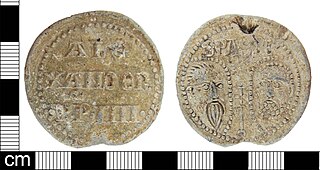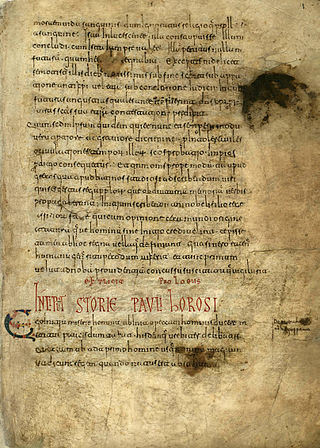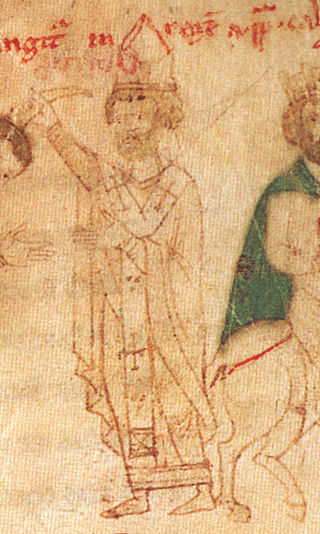
A chronicle is a historical account of events arranged in chronological order, as in a timeline. Typically, equal weight is given for historically important events and local events, the purpose being the recording of events that occurred, seen from the perspective of the chronicler. A chronicle which traces world history is a universal chronicle. This is in contrast to a narrative or history, in which an author chooses events to interpret and analyze and excludes those the author does not consider important or relevant.

Pope Alexander IV was head of the Catholic Church and ruler of the Papal States from 12 December 1254 to his death.

Pope Honorius III, born Cencio Savelli, was head of the Catholic Church and ruler of the Papal States from 18 July 1216 to his death. A canon at the Basilica di Santa Maria Maggiore, he came to hold a number of important administrative positions, including that of Camerlengo. In 1197, he became tutor to the young Frederick II. As pope, he worked to promote the Fifth Crusade, which had been planned under his predecessor, Innocent III. Honorius repeatedly exhorted King Andrew II of Hungary and Emperor Frederick II to fulfill their vows to participate. He also gave approval to the recently formed Dominican and Franciscan religious orders.
William of Malmesbury was the foremost English historian of the 12th century. He has been ranked among the most talented English historians since Bede. Modern historian C. Warren Hollister described him as "a gifted historical scholar and an omnivorous reader, impressively well versed in the literature of classical, patristic, and earlier medieval times as well as in the writings of his own contemporaries. Indeed William may well have been the most learned man in twelfth-century Western Europe."

The Spring of Bandusium is a natural water source in rural Italy, to which the Roman poet Horace addressed a well-known ode. The location is thought to be the site of poet's beloved Sabine farm in what is now the commune of Licenza. In the poem Horace promises to sacrifice a young goat to the spring and praises the spring's constancy in the hottest days of summer. The poem ends with Horace promising to immortalize the spring through his song.
GaufredoMalaterra was an eleventh-century Benedictine monk and historian, possibly of Norman origin. He travelled to the southern Italian peninsula, passing some time in Apulia before entering the monastery of Sant'Agata at Catania, on the isle of Sicily. Malaterra indicates that, prior to his arrival in Catania, he had spent an undefined period away from monastic life, in the worldly service of "Martha".
Falco of Benevento was an Italian-Lombard twelfth-century historian, notary and scribe in the papal palace in Benevento, his native city, where he was born to high-standing parents.

Alfonso, also called Anfuso or Anfusus (c. 1120 – 10 October 1144), was the Prince of Capua from 1135 and Duke of Naples from 1139. He was an Italian-born Norman of the noble Hauteville family. After 1130, when his father Roger became King of Sicily, he was the third in line to the throne; second in line after the death of an older brother in 1138. He was the first Hauteville prince of Capua after his father conquered the principality from the rival Norman Drengot family. He was also the first Norman duke of Naples after the duchy fell vacant on the death of the last Greek duke. He also expanded his family's power northwards, claiming lands also claimed by the Papacy, although he was technically a vassal of the Pope for his principality of Capua.

The Códice de Roda or Códice de Meyá is a medieval manuscript that represents a unique primary source for details of the 9th- and early 10th-century Kingdom of Navarre and neighbouring principalities. It is currently held in Madrid as Real Academia de la Historia MS 78.
William was the Count of Monte Sant'Angelo from 1102 to 1104. He succeeded his brother, Henry, on his death.

The 1119 papal election was, of all the elections currently considered legitimate by the Roman Catholic Church, the smallest papal election of the twelfth century.
Ottaviano di Poli, a member of the family of the Counts of Poli, was an Italian Roman Catholic Cardinal.
The 1254 papal election took place following the death of Pope Innocent IV and ended with the choice of Raynaldus de' Conti, who took the name Pope Alexander IV. The election was held in Naples, in the former palazzo of Pietro della Vigna, and required only one day.

The 1191 papal election took place after the death of Pope Clement III. Pope Clement, according to differing and irreconcilable reports, died in March 1191, in the last third of the month, on the 20th, the 25th, the 26th, the 28th, or perhaps 2 April or 4 April, or 10 April. The election was conducted during the march of King Henry VI and his army toward Rome. The 85-year-old Cardinal Giacinto Bobone, a member of the Orsini family, was chosen after some extreme reluctance. He took the name Celestine III. Pressed by the Romans, however, he agreed to negotiate with King Henry about his coronation as emperor and about the possession of the city of Tusculum. Celestine postponed his own consecration in order to buy time to negotiate. He was finally crowned on Easter Sunday, 14 April 1191.

The 1118 Papal Election was held to choose the successor for Pope Paschal II, who died in Rome on 21 January 1118, after an 18-year pontificate. Pope Gelasius II was elected as his successor. The election happened during the Investiture Controversy, a conflict between supporters of the Papacy and those of the Holy Roman Emperor. The election was held under the threat of possible violence due to the controversy. The Cardinal electors took refuge in the Benedictine monastery, S. Maria in Pallara, during the election. Within minutes of his election as pope, Gelasius II was attacked and imprisoned by the Frangipani faction, supporters of the Holy Roman Emperor. Gelasius managed to escape, but at the emperor's arrival with his army, he fled Rome and never returned.
The Abbey of Santa Maria della Ferraria was a Cistercian monastery located in Vairano Patenora, Province of Caserta, Italy. Presently only ruins remain.

Niccolò Brancaccio was born in the Kingdom of Naples, perhaps in Naples itself. He was Archbishop of Bari and then Archbishop of Cosenza, while serving in the Roman Curia in Avignon. He became a cardinal of the Avignon Obedience in 1378, and was Cardinal Priest of Santa Maria in Trastevere and then Cardinal Bishop of Albano. He participated in the Council of Pisa in 1409, and was one of the electors of Pope Alexander V and of Pope John XXIII.
Joannes was a 12th century Roman Catholic Cardinal, and Cardinal-priest of the titulus of Santa Cecilia in Trastevere in Rome. Alfonso Chacón writes that he was a member of the Capizucchi family, but he was deceived by the forgeries of Alfonso Ceccarelli, a contemporary acquaintance. In fact, according to Agostino Paravicini Bagliani, in the 11th and 12th centuries the Capizucchi family had no cardinals.
Melior, O.S.B. Vall. was a Benedictine monk, and a cardinal of the Roman Catholic Church. He was a native of Pisa. He served as papal legate in France for more than three years, trying to arrange a peace between Richard I and Philip II. He became a major negotiator, on the mandate of Pope Celestine III, in the divorce case between King Philip II of France and Queen Ingeborg of Denmark.
Rerum italicarum scriptores ab anno æræ christianæ quingentesimo ad millesimumquingentesimum is a collection of texts which are sources for Italian history from the 6th to the 15th century, compiled in the 18th century by Ludovico Antonio Muratori.